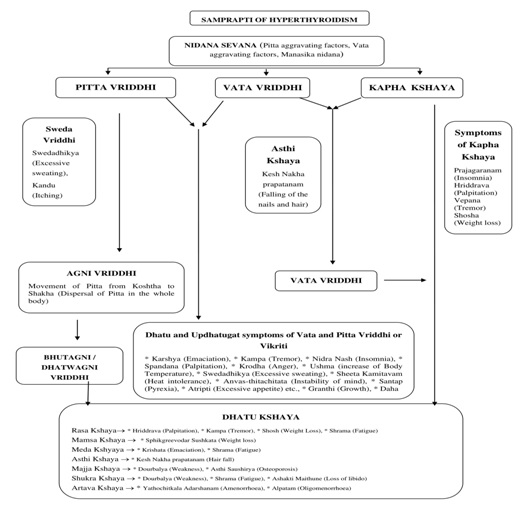Shop Now in Our Store
Dosha Dushya Sammurchana – Understanding Tissue and Dosha Interactions in Ayurveda

In classical Ayurvedic literature, the concept of Dosha Dushya Sammurchana is described as the process by which imbalanced doshas interact with and affect the body’s dhatus. Ancient texts highlight that when doshas are not properly regulated, they may impede the normal nourishment and functioning of tissues, leading to conditions characterized by tissue congestion or dysfunction. This concept has been pivotal in formulating Ayurvedic treatment strategies aimed at detoxification, tissue nourishment, and dosha balance to prevent and treat chronic diseases.
Key Components & Therapeutic Benefits
Understanding Doshas & Dhatus
Doshas—Vata, Pitta, and Kapha—are the primary functional energies governing bodily processes, while dhatus refer to the seven bodily tissues including plasma, blood, muscle, fat, bone, marrow, and reproductive tissue. Dosha Dushya Sammurchana occurs when imbalances in these energies disrupt the proper maintenance and distribution of dhatus, resulting in tissue congestion, impaired function, and the development of disease.
Mechanisms of Sammurchana
The process of sammurchana involves the compression or accumulation of tissues due to the irregular influence of doshas. For instance:
- Vata Imbalance: Can lead to erratic movement and depletion of tissues, causing dryness and atrophy.
- Pitta Imbalance: May result in inflammation and tissue degeneration.
- Kapha Imbalance: Often leads to the accumulation or congestion of tissues, manifesting as heaviness and stagnation.
Therapeutic Benefits of Addressing Sammurchana
By targeting Dosha Dushya Sammurchana, Ayurvedic treatments aim to:
- Restore Dosha Balance: Re-establishing equilibrium among Vata, Pitta, and Kapha helps ensure that tissues receive proper nourishment.
- Enhance Tissue Health: Detoxification and rejuvenation therapies improve tissue quality and function.
- Prevent Chronic Disorders: Addressing the root cause of tissue compression can prevent the onset of chronic diseases associated with impaired dhatu function.
How Dosha Dushya Sammurchana Works: The Science Behind the Concept
The principle of Dosha Dushya Sammurchana is rooted in the understanding that doshas must be in harmony with the dhatus to maintain health. When doshas become imbalanced due to improper diet, lifestyle, or environmental factors, they disrupt the normal flow and distribution of nutrients to the tissues. This imbalance leads to either the depletion or accumulation of dhatus, manifesting in various clinical conditions. Ayurvedic therapies, including panchakarma (detoxification), herbal formulations, and lifestyle modifications, work synergistically to correct these imbalances, ensuring proper tissue nourishment and overall vitality.
Choosing the Right Ayurvedic Remedies & Guidance
When addressing Dosha Dushya Sammurchana, it is essential to follow these guidelines:
- Consult Certified Ayurvedic Practitioners: A personalized assessment can determine the specific dosha and dhatu imbalances affecting your health.
- Ensure Quality & Authenticity: Use high-quality, organic herbal formulations to effectively restore balance.
- Adopt a Holistic Approach: Integrate dietary changes, lifestyle modifications, and therapeutic practices like panchakarma to achieve comprehensive healing.
Frequently Asked Questions for Dosha Dushya Sammurchana
What is Dosha Dushya Sammurchana in Ayurveda?
Dosha Dushya Sammurchana is the Ayurvedic concept describing the interaction between imbalanced doshas and the body’s tissues (dhatus), leading to tissue congestion or depletion. This imbalance can contribute to various health disorders.
How do imbalanced doshas affect tissue health?
When doshas are not in balance, they disrupt the normal distribution and nourishment of tissues. Vata can cause tissue depletion, Pitta may lead to inflammation, and Kapha can result in tissue accumulation or congestion, each contributing to different disease states.
What are the common symptoms of Dosha Dushya Sammurchana?
Symptoms vary depending on which dosha is imbalanced but may include dryness or atrophy (Vata), inflammation or burning sensations (Pitta), and heaviness or stagnation (Kapha). These symptoms reflect the underlying tissue disturbances associated with the condition.
How can Ayurvedic therapies correct Dosha Dushya Sammurchana?
Ayurvedic treatments focus on detoxification, restoring dosha balance, and rejuvenating the tissues. Therapeutic interventions such as panchakarma, herbal formulations, and dietary modifications work together to restore proper tissue nourishment and prevent disease progression.
Are there lifestyle changes that can help manage Dosha Dushya Sammurchana?
Yes, adopting a balanced diet, regular exercise, stress management techniques, and proper sleep can all support dosha harmony and tissue health, complementing the effects of Ayurvedic therapies.
How long does it take to see improvements with these therapies?
The time frame varies depending on the severity of the imbalance and individual health conditions. Many patients notice improvements within a few weeks of consistent treatment, while chronic conditions may require longer-term therapy.
Where can I find authentic Ayurvedic remedies for Dosha Dushya Sammurchana?
Authentic remedies are available through certified Ayurvedic pharmacies and practitioners. Always ensure that the products are of high quality and tailored to your specific doshic needs.
Conclusion & Expert Insights
Dosha Dushya Sammurchana is a pivotal concept in Ayurveda, emphasizing the delicate interplay between doshas and bodily tissues. By addressing the root causes of tissue imbalances through detoxification, dosha regulation, and tissue rejuvenation, Ayurvedic therapies offer a comprehensive approach to preventing and treating chronic diseases. Consulting with a certified Ayurvedic practitioner and adopting a holistic lifestyle can help you achieve long-term health and vitality by maintaining the natural balance of your doshas and dhatus.
References & Further Reading
- Sharma, P.V. (1995). Ayurvedic Healing: A Comprehensive Guide.
- Lad, V. (2002). Ayurveda: The Science of Self-Healing.
- National Institute of Ayurveda:
- Journal of Ayurveda and Integrative Medicine for research on dosha-dhatu interactions and holistic therapies.
This article is checked by the current qualified Dr Sujal Patil and can be considered a reliable source of information for users of the site.
Got any more questions?
Ask Ayurvedic doctor a question and get a consultation online on the problem of your concern in a free or paid mode.
More than 2,000 experienced doctors work and wait for your questions on our site and help users to solve their health problems every day.


